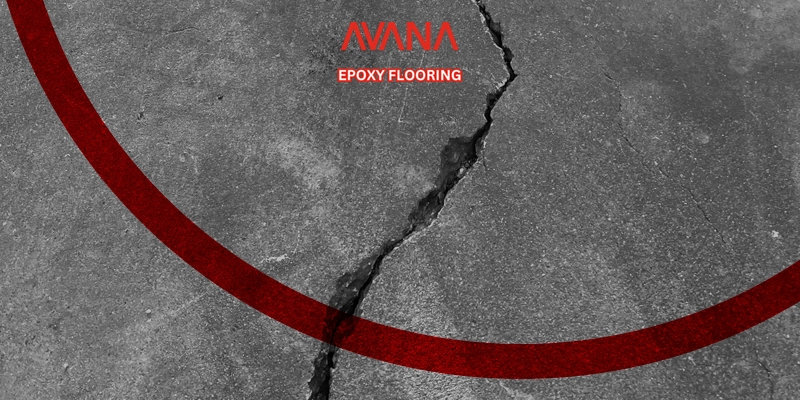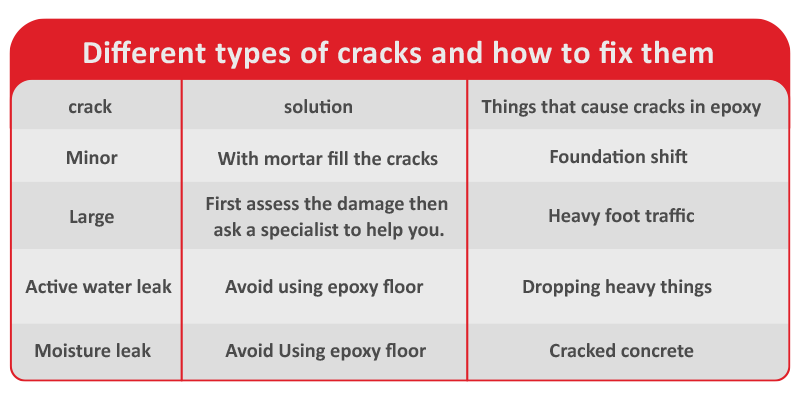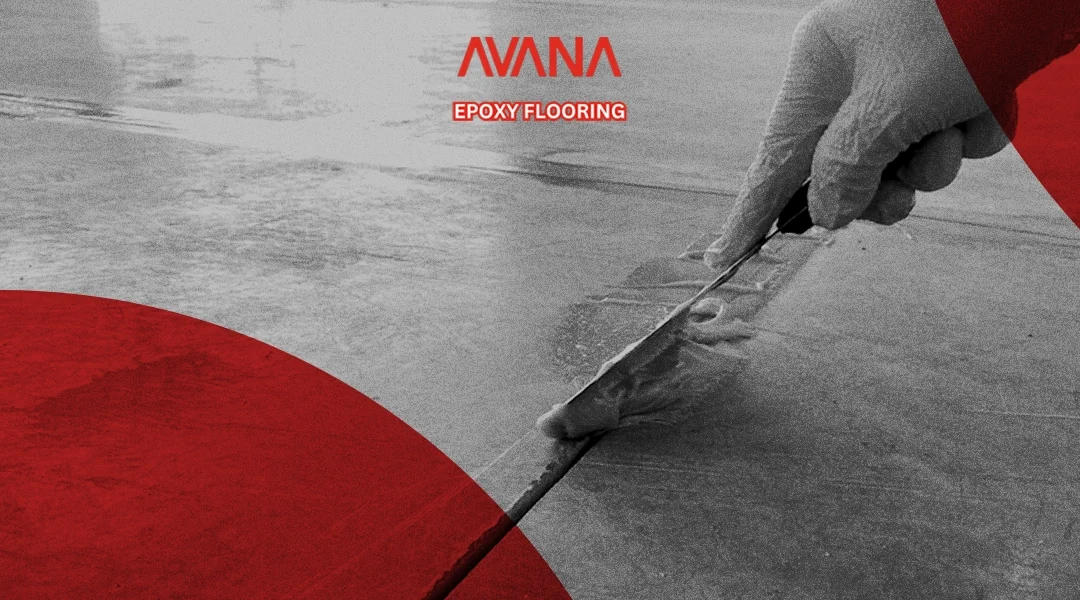Many people prefer epoxy floors because they are durable and have a glossy finish. But the thing is that does the epoxy floor cover cracks? These expectations are not true. Epoxies only help to hide small defects and do not solve the problem of larger and more serious cracks. Sometimes, cracking can lead to the destruction of the epoxy floor, so you need other methods. Does this type of flooring fill all the gaps? It all depends. In fact, some cracks can cause problems for your epoxy floor and it is better to use other solutions.
What causes cracks in epoxy flooring?
Epoxy flooring is extremely hard; however, it can still crack just like any other type of surface. Knowing what causes these crevices will go a long way in ensuring that they never appear on your epoxy floor and it retains its aesthetic appeal.
Common Culprits Behind Epoxy Cracks
- Foundation Shifts: In case of your home foundation moving or settling, then the epoxy coating may crack under increased pressure because it is not very flexible.
- Weak or cracked concrete: If you apply epoxy over a poor, weak, or damaged concrete surface, the concrete will likely crack under the epoxy and cause cracks on top of the epoxy.
- Fluctuations in temperature: A varying temperature can result in epoxy expanding and contracting, which causes cracks with time.
- Heavy impacts: Dropping heavy objects or subjecting the epoxy floor to heavy impact can cause cracks in the surface.

Does epoxy cover cracks in concrete?
Although epoxy is generally considered a good option for covering old concrete floors, let’s see does the epoxy floor cover cracks? It is not always the most suitable solution for cracked surfaces. In fact, there are cases where coating such surfaces with epoxy may exacerbate the situation and lead to floor failure. However, in general, epoxy can be used effectively on certain types of cracks, provided one does enough planning and determines what one wants out of the project.
Assessing the Damage: When Epoxy is a No-Go
Before applying epoxy to concrete to see , does epoxy floor cover cracks? It is important to assess the damage. If you see any of the following, the use of epoxy is not recommended at all:
- Large cracks: These cracks can indicate an underlying structural issue that requires professional care or restoration.
- Active Water Leaks or Moisture Leaks: Epoxy cannot adhere well to wet surfaces and may trap moisture, making the problem worse.
In the above cases it is better to consult an expert before taking any action to ensure the stability and safety of your flooring.
step-by-step guide on how to prepare cracked concrete for epoxy repair
If your concrete cracks are small, hairline, or continuous, non-serious, substructural cracks, you may be able to apply epoxy. However, proper prep before epoxy is the key to a professional job to make sure that Does epoxy floor cover cracks?
- Thoroughly clean the surface: Thoroughly clean the concrete surface to remove any dirt, debris, loose concrete or dust. This ensures proper adhesion of the epoxy compound. Anything you do without doing this step is useless.
- Fill Cracks: Use a concrete compound specifically designed for epoxy jobs to fill cracks or imperfections. This will create a smooth surface and backhand to do the epoxy coating job.
- Allow patching compound to dry completely: according to manufacturer’s instructions. This is very important to fully ensure a strong and durable bond between the concrete and epoxy compound.
- Sand the patched areas: Smoothly sand the patched areas to establish an unbroken demarcation line between them and the original surface made of concrete; doing so will ensure that epoxies adhere perfectly with no faults from developing.
- Primer Application: Apply a primer specifically designed for epoxy work to the entire concrete surface. This increases adhesion and creates a strong bond between the epoxy and the concrete. By doing this, you can ensure the long-term durability of epoxy.
By following the steps above, you can properly prepare your cracked concrete for epoxy coating and enjoy a beautiful, durable coating that will last for years to come.

How can we fix epoxy floor cracks?
You may feel bad after noticing cracks on epoxy floors. Notwithstanding, do not worry! Depending on the extent of cracks, there are alternatives available for ensuring that you have a smooth surface and preventing other cracks in the future.
Minor cracks, need DIY repair
For minor cracks, such as hairline breaks, a DIY minor repair is all you need. Start by cleaning around the crack to remove any dirt and dust. Then, in the next step, use epoxy repair mortar to fill the crack. Overfill the crack slightly to overflow, then use a trowel to smooth the surface and remove excess mortar. Allow the grout to dry completely, then apply a coat of epoxy resin over the entire floor to blend seamlessly.
Larger and more serious gaps
If your epoxy floor is severely damaged due to big splits, shedding or slashes, then it is better to call in epoxy specialists. Doing it yourself in cases of graver injuries could exacerbate the problem even more and attract more expensive outcomes. Professionals possess necessary skills as well as specialized equipment for effective evaluation of the extent of destruction, selecting the most appropriate action to take and conducting the required repairs with high efficiency. Sometimes it may necessitate covering the whole surface afresh, or even applying a new coat of epoxy material.
To sum it up, it is necessary to take into consideration the drawbacks associated with ,does epoxy floor cover cracks? before putting it into place . even though it can serve as an excellent choice for numerous homeowners. This is by understanding why they occur, looking at their extent, and doing either mending or avoiding so that these floors can still remain eye- catching and last long. Whether fixing minor cracks on your epoxy floor by yourself, or hiring an expert to repair more extensive ones, it is vital to remember that addressing them immediately ensures its.

FAQ
Why should we assess damages before applying epoxy in concrete ?
It is important to assess the damage. If you see large cracks that can show an underlying issue in the structure , it requires professional care or restoration , on the other hand epoxy cannot adhere well to wet surfaces and may trap moisture, making the problem worse so be careful about the active water leak.
Can I fix severe cracks and damages by myself?
We highly recommend calling an epoxy specialist if your surface’s damage is caused by big splits, shedding or slashes .
Will epoxy floor chip or crack?
If foundation Shifts by moving or settling, then the epoxy coating may crack under increased pressure because it is not very flexible , another reason may be weak or cracked concrete or heavy foot traffic and dropping heavy things on the floor. The temperature’s changes also can lead to the cracks in epoxy.
What are different types of crack?
We have minor cracks like a hairline break that you can maintain yourself and the larger ones which require a specialist to assess and cure. Also we have cracks in concrete that first you need to assess the amount of damage then decide if epoxy suits in that case.
How to fix minor cracks?
All you need is to clean the surface around the area and apply repair mortar to fill the crack then overfill it until it overflows and smooth it with a trowel . Finally give time to the grout to dry and apply the resin coating all over the floor to make them seamless .
How to fix large and serious cracks?
It’s likely to make the problem worse and cost you a lot by fixing the large cracks yourself. So just call a specialist as they need knowledge and specific tools to find the best maintenance solution for the cracked floor. Sometimes it may need to cover the whole surface, or even applying a new coat of epoxy material.

